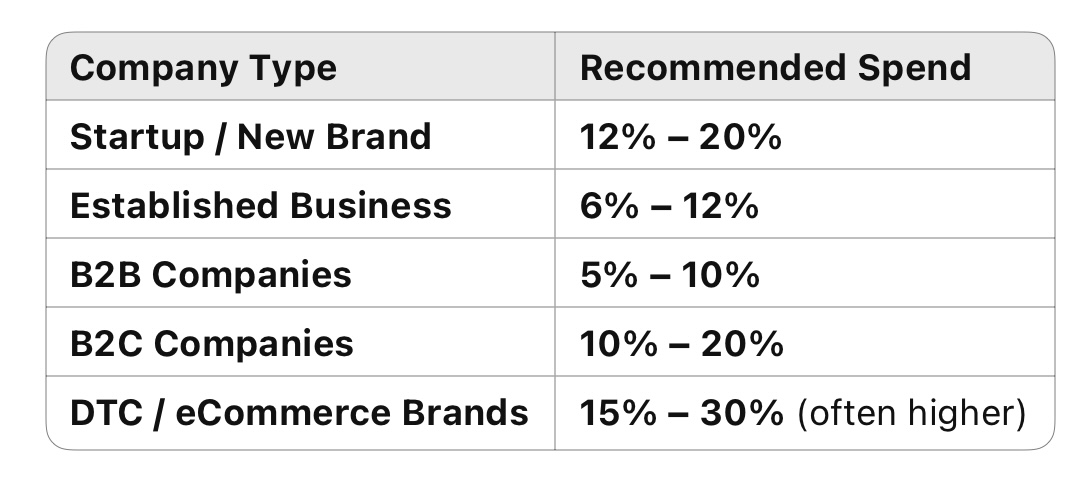
Stay Informed
Get the latest news, trends, and industry insights.
How much should allocate to marketing? Well, each year, businesses around the world start, grow, or maintain, and they think about what percentage of their top line, gross revenue they should dedicate to marketing. Oddly, many business — especially start-ups — think marketing isn't as important as many other items on your P&L. I've seen product inventors turn to entrepreneurs and think so highly of their product "it'll just sell itself." (Famous last words.) Others really believe in marketing, but simply don't have the funds, and while a business or product launch should be predicated on ample capital to sustain just those marketing efforts, many roll the dice. And fail.
The truth is marketing is an important driver for your sales — Note: Public relations is not marketing — and while the range fluctuates on the percetnage of gross revenue you should spend, one thing is for sure: You should spend it.

The variation in the percentage differs because of the state of the business or type of channel upon which it sell. Startup should have a higher spend, where generating awareness is monumental, while well-known, legact brands with ample equity can often peel off a little. B2B companies often spend less, but focus more on in-person events and Account-Based Marketing (ABM), while DTC brands spend heavily on performance marketing (social, PPC, influencers, etc.), among other digital channels.
Once you’ve committed to your annual budget [...] that's when the real work begins.
Once you’ve committed to your annual budget, your pitch deck, business plan, or maybe your established business' 5-year plan, that's when the real work begins: allocating that percentage you set aside with intention. Here’s where the sharpest brands are placing their bets so far in 2025.
The Evolution Revolution
Traditional advertising (TV, print, radio, OOH, etc.) used to dominate up to 35% of marketing budgets. Not anymore. In 2025, that’s shrunk to just 20%, and digital now leads the charge. Brands like Dollar Shave Club and Warby Parker (brands that started as Digitally-Native, Vertical Brands) didn’t wait for permission — they poured 90%+ of their early budgets into digital, and it paid off.
If we're taking broad strokes here, then let's look at the typical new breakdown of your marketing dollars allocated:
General Market Allocation:
- Traditional Channels – 20% (Still valuable. Coca-Cola puts ~25% here.)
- Brand Publishing – 14% (Red Bull, anyone?)
- Search Ads – 15% (HubSpot owns this space.)
- Display Ads – 12% (Airbnb’s immersive visuals crush CTRs.)
- Programmatic – 15% (P&G saw 30% efficiency gains here.)
- Social Media – 16% (Glossier built a $1.2B brand from Instagram alone.)
- Website & E-commerce – 10% (Amazon’s conversion game is relentless.)
Tactical Budget Breakdown:
- Paid Display – 16% (41% of it is retargeting)
- Social Media Marketing – 14%
- Traditional Marketing – 13%
- Email Marketing – 10%
- Content Marketing – 10%
- SEO – 10%
- Search (PPC) – 9%
- Landing Pages/Websites – 9%
- Affiliate Marketing – 9%
Forget the silos. Smart brands use these levers together — testing, tracking, and iterating with ruthless focus.
B2B, however, is a different beast
You’re not selling Taylor Swift knitted blankets on Instagram. Now, B2B marketing is slower, deeper, and built on trust.
- Exhibiting at Industry Events – 40.7% (Salesforce’s Dreamforce alone generates over $1B in pipeline)
- Web + SEO – 7.9% (Adobe kills this with high-value inbound content)
- Consumer Exhibiting – 6.9%
- Trade Mag Ads – 6.6%
- Trade SEO/Web – 5.5% (Oracle owns technical SEO)
- Event Sponsorships – 5.6%
- Corporate Events – 4.7%
- Trade Email Campaigns – 4.2% (ServiceNow is the benchmark here)
This is about credibility and conversion. Not going viral.
Healthcare plays by different rules
Compliance. Ethics. Trust. Healthcare isn’t just another vertical — it’s an ecosystem with its own playbook, and marketing, as well as branding, are essential for success. However, their breakdown a little more skewed toward traditional, with some other channels (ahem, patient education) thrown in.
- Online Paid Ads – 16%
- Patient Education – 14%
- Websites – 14%
- TV/Radio – 12%
- Billboards – 10%
- Print – 9%
- Email – 6%
- Strategy – 6%
- Signage – 5%
- Promo Items – 4%
- Data Analytics – 4% (And that’s the problem.)
That last stat should give you pause. While most healthcare orgs barely touch analytics, disruptors like Simpliphy, One Medical and Teladoc are spending 15–20% here. Why? Because they’re laser-targeting patient journeys and dropping acquisition costs by 30%. That’s not innovation—it’s dominance.
Break the rules, then rewrite them
Here’s the truth you won’t hear in your typical “Marketing 101” webinar: These budget percentages? They’re starting points, not sacred law.
The smartest brands test, track, and reallocate in real time.
- Notion grew to $10B with zero traditional spend—70% of their marketing went to content and community.
- Shopify ignored the norms, pouring 35% of their budget into partner programs (when the benchmark said 10% max).
- Purple Mattress? They broke the mattress mold by throwing 70% of their spend into offbeat YouTube content while competitors stayed safe in Google Ads.
Benchmarks are for the average. You’re not here to be average.
So, what are you choosing?
Are you bold enough to rethink your budget? Are you willing to put your money where your strategy is? Because in 2025, the brands that rise won’t be the ones that did what everyone else did — they’ll be the ones that dared to spend differently.
If you're ready to stop playing by someone else's playbook and start building your own, we should talk.
Stay Informed




